#Extant corsets
Explore tagged Tumblr posts
Text
here's a secret about actual Victorian gowns:
the interiors are usually messy as hell
raw edges on seams? finished with the absolute mimimum of work necessary to keep them from fraying into nonexistence. it's not going to touch the person's actual body, given the layers of corset-cover + corset + chemise/combinations in between, so it doesn't matter how it feels on bare skin. pinked and left raw? I've seen that, sure. whipstitched down to the bodice's structural flat-lining fabric? yep! I've seen VERY few bodices nicely lined so the innards don't show; that seems more common on capes, cloaks, and coats. you know, where the lining might end up being visible. because "will it be visible?" is the defining factor here
got a skirt you know will only be worn with an opaque overskirt? why bother making the whole thing out of that expensive silk? go ahead and make the covered part out of unbleached muslin- nobody will see it! (this was not universal, to be clear, but I have seen extant examples of the practice)
one of my museums has a Worth gown. couture! Parisian! guess how :) huge and gappy and messy :) the stitches holding the trim on look from the underside :)
undergarments and nightwear tend to have finished seams because they'll go next to the skin. they also tend to have visibly top-stitched machine hems, because the Hand-Sewn Hems rule only applied to garments that anyone outside the wearer's innermost circle would see. lingerie? machine-sew that hem! the poor underpaid piece-worker has a hundred more of these to make before her shift is over!
Victorians were the epitome of Work Smarter, Not Harder in their clothing, so don't feel like your recreations have to be perfectly finished unless it brings you joy to do it that way
5K notes
·
View notes
Note
Congratulations on your nuptials. You and your husband look so happy and lovely. (If you want to to) it would be great to hear more details about your lovely dress. Congratulations again :-)
Thank you!
It's based off an extant gown from the 1890s, likely 1895-1896.
It's bespoke, vintage silk faille fabric and contemporary silk/rayon duchess satin for the ribbon details and bow tie, and it was patterned, draped, fit and sewn with historic techniques by @lunarrosecostuming on IG (my friend). The boutonnières on either of us are vintage millinery flowers that I picked out. Some of those flowers are also in my hair, styled to look like wax flowers from wedding portraits from the turn of the century, with an updo styled of the period as well.
Beneath, I am wearing a combination chemise, steel boned overbust corset (that deserves a post in its own right) and 3 petticoats! No corset cover though.

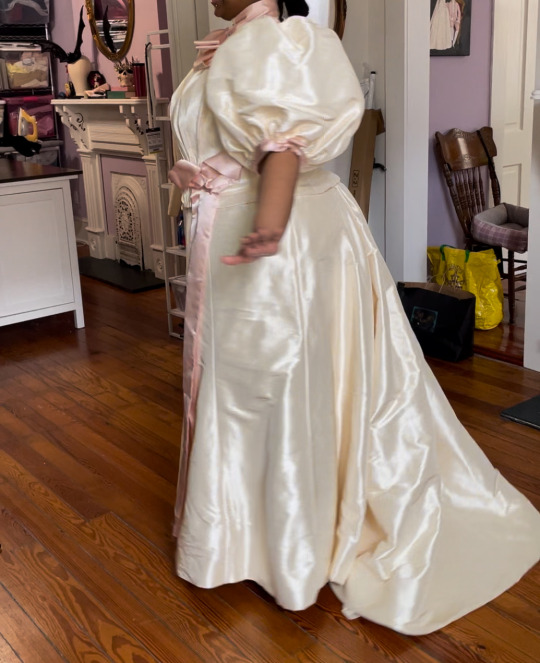
201 notes
·
View notes
Note
This is kind of random, but would it have been a struggle for a big busted women to wear fashionable silhouettes in the medieval era? I’ve heard some costume historians discuss that there were forms of bust support, but most of what I’ve seen pre-1500s seems like it would have been a nightmare for any ancestor with a similar bodytype to wear. Am I just from a line of women doomed to horrible back pain? (On the flip side of the situation, I’ve found corsets and stays to be rather comfortable, so that’s not a problem)
As a fellow big boob haver, I have good news for you! There were pretty good Medieval bust supporting garments and I have tested one of them.
With sturdy fabric, tailoring and lacing you can create pretty good bust support. Lacing was popularized first in 12th century in form of bliaut, and in 14th century tailoring became standard for everyday garments. I don't know how well bliaut supported the bust, but since it doesn't fit super snugly, I assume it doesn't distribute the weight of the boobs as well as tailored supporting garments and therefore isn't as supportive. I'm also not actually sure if there was proper bust supporting garments before that, I haven't looked into it. I know Romans bound their breasts with cloth wrapped around the chest, so maybe that technique continued (at least for those who especially needed it) till lacing and tailoring became a thing. For more about how supporting garments developed in Europe through history, I have a post about development of lacing, which coincides pretty well with that history from 12th century forward.
Personally I have experience with Medieval Bathhouse dress, which was used in the Germanic Central-European area roughly in 14th to 16th century. It's called the Bathhouse dress because most depictions of it are from bathhouse settings, but there's depiction also in bed chambers and other contexts, so I think it's pretty safe to assume it was used more generally as an undergarment. It often had separate cups for the boobs (see the only extant garment left of it, the so called "Lengberg Castle Bra"), but not always. Unlike most other undergarments at the time, it was sort of a shift (the lowest layer) and a supporting garment combined into one.
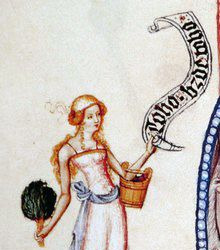
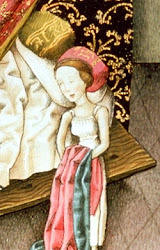
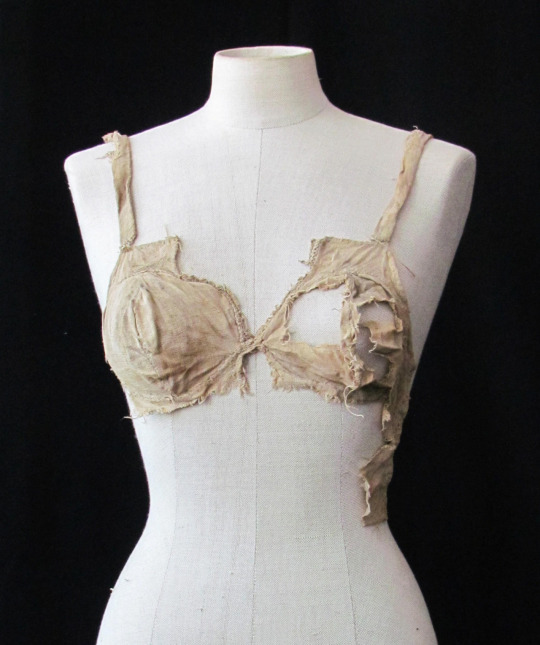
I sewed my own recreation of it (with some alterations because I made it for my everyday use, not as a historical recreation) and did a post about my results, where I go deeper into the history of the garment too. I didn't construct it very well and I did an error in the design of the back, which cause the strain of the shoulder straps to focus too much on very specific spots in the back panel, which eventually made the fabric there break too many times. (There were some other smaller design flaws too, like the waistline is lower than my natural waist so it rose and wrinkled annoyingly.) I did use it daily (except when I washed it) for a fairly long time though and it was super comfortable and helped a lot with back pain (and shoulder pain caused by use of modern bras). I hate that I've had to go back to modern bras because I haven't had the time to remake it yet. (I'll probably make a follow up post once I get around to it, where I go through the issues of the first version and how I addressed them in the next attempt.) Well fitted and shaped bodice which is then laced does surprisingly much even without any additional reinforcements.
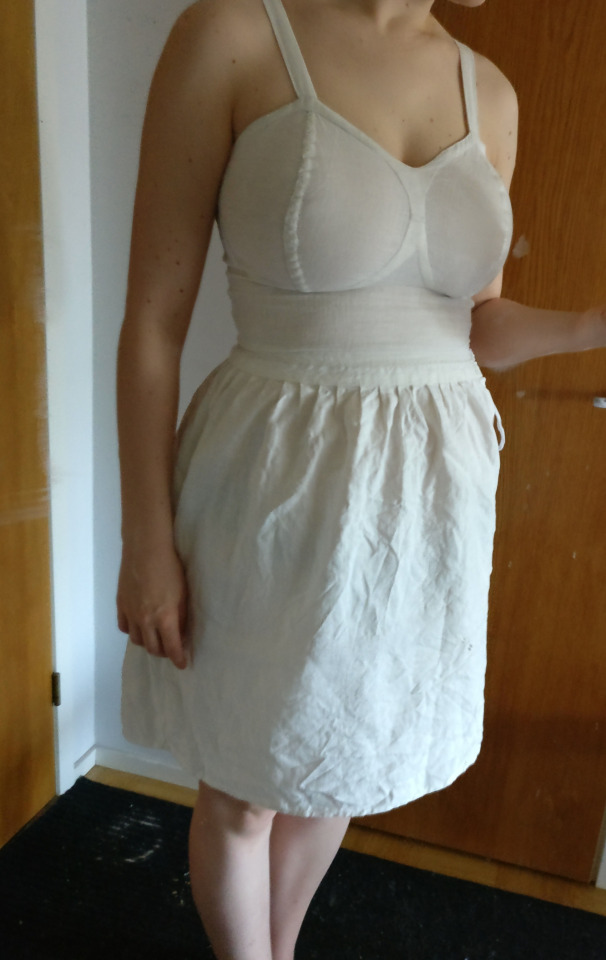

I haven't made a Medieval kirtle (though I will some day), but it was the more widely used Medieval supporting garment, which eventually replaced Bathhouse dress in the area where that was used. Kirtle is worn over a shift, but it broadly works similarly. Kirtles could be front, side or back laced depending on the time period and how the Kirtle was constructed. Multiple layers of kirtles could be used and looser overgarments (like houppelande) were often used on top of it. Kirtle was used by everyone, including men, but for those who didn't need bust support, it's purpose was mainly to create the fashionable silhouette. Here's three depictions of kirtles from 15th century. First unlaced, but has lacing on the front, second close up of the side lacing and third shows nicely how both front and side/backlacing shaped the bust.
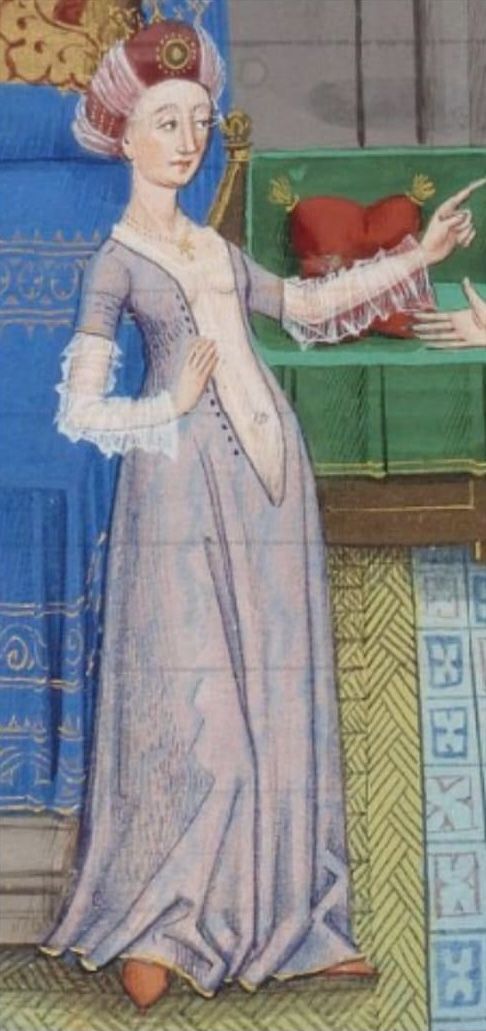
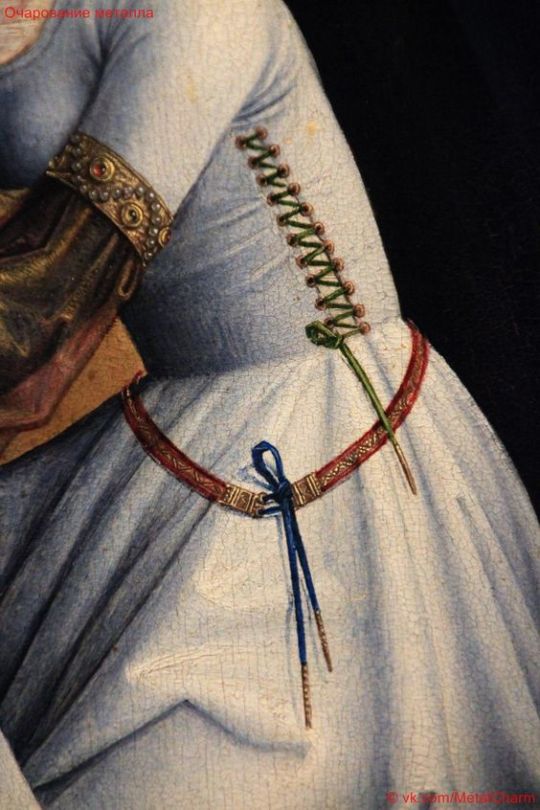
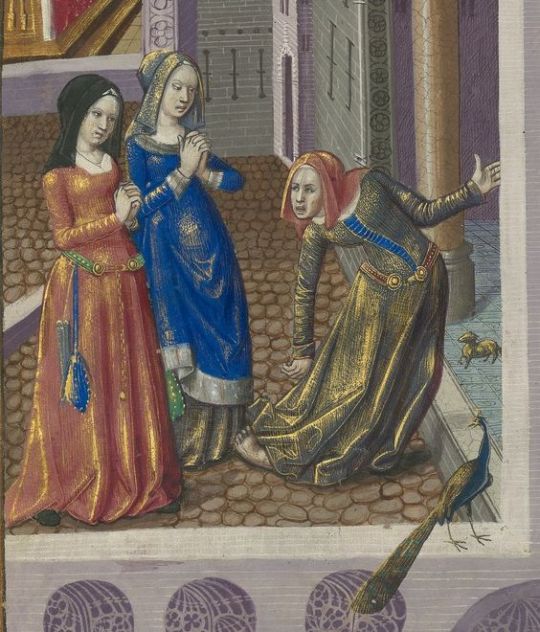
Morgan Donner is a costumer, who focuses a lot on Medieval costuming and has a big bust, so while I haven't personally tested the supportiveness of kirtle, she certainly has. The kirtle bodice part needs to be patterned to accommodate the breasts by giving it round shapes and the kirtle needs to be a little too small so there's room to lace it to fit well. Lining also helps to reinforce the fabric and make it more firm and supportive. Here's Morgan's pattern from the tutorial in her website and how the kirtle eventually fits for her. (Also look at the handsome boy in his handsome matching outfit.)
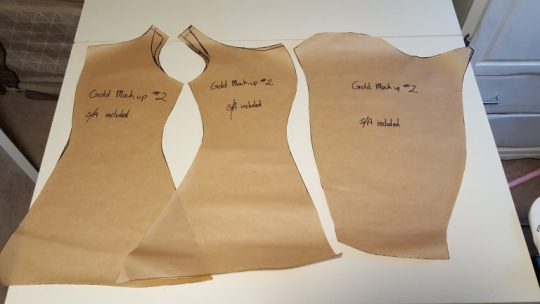
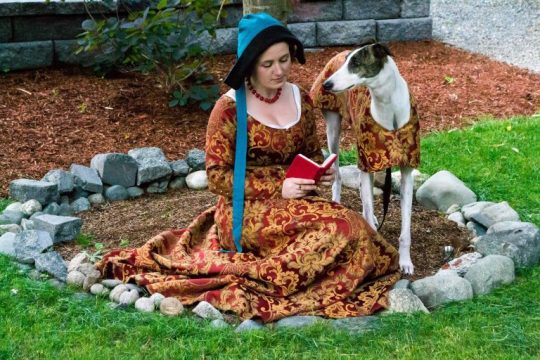
She also has a video relating to the same kirtle project, where she explains her method to pattern a kirtle specifically so it's supportive for big bust.
In 16th century more stiffness was added to kirtles, first with very stiff lining and then with boning, but that doesn't necessarily add to the bust support, rather it just allows the kirtle to shape the bust and the body in general more and better support a heavy skirt. Firm fabric secured snugly with lacing is already very good at distributing the weight of the boobs to the whole torso.
In conclusion, at least since 14th century people with our body type were not doomed to eternal back pain and even before that some ways to help with it were probably used.
#historical fashion#fashion history#dress history#history#historical costuming#historical sewing#sewing#crafts#costuming#fashion#medieval fashion
277 notes
·
View notes
Text
☆Update 2:☆
I remembered to take pics today! Sort of. Only after i had put away my machines and stuff...
Here are (most) of my edwardian undergarments
(i am wearing modern clothes under bcs the internet is weird)
Chemise, bustle pad, underbust corset, petticoat
I still need to make a corset cover someday, ive just been using a second thin chemise over all this:
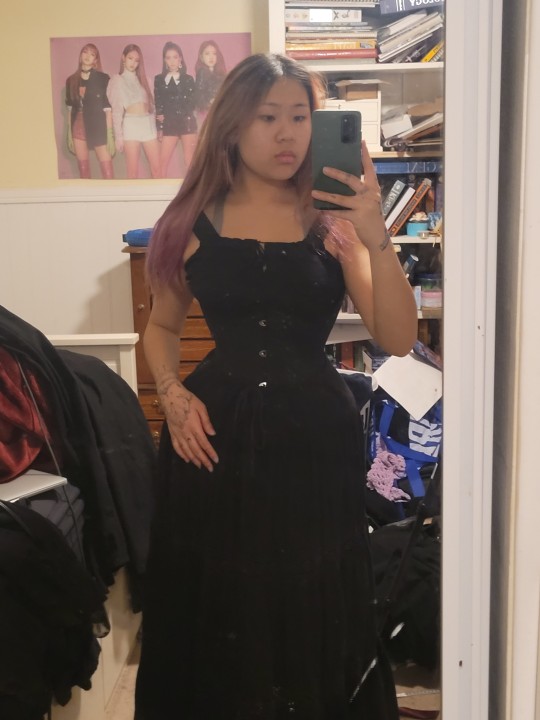
I used these vintage buttons on the cuffs. I wanted some more security but ran out of buttons so i used small snaps:
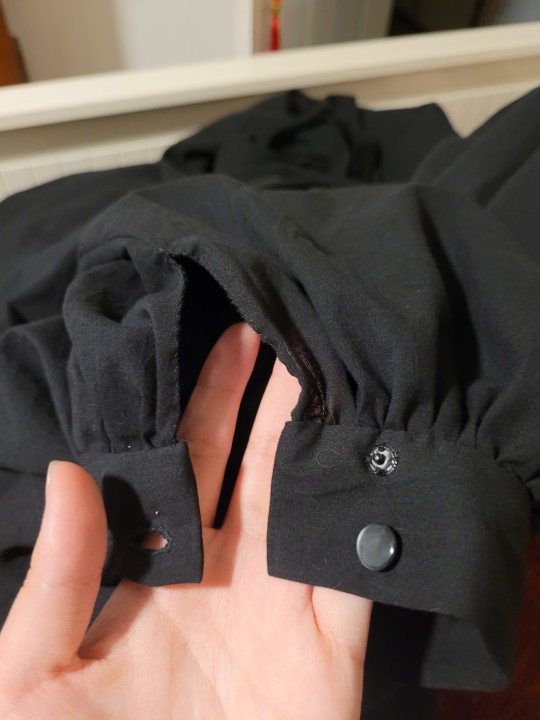
Also put one on the collar so i could try it on. I think the placket at the back of the blouse is a little ugly and larger than ive seen in extant garments but i forgot to adjust the pattern for my broad shoulders and need the extra width for comfort.
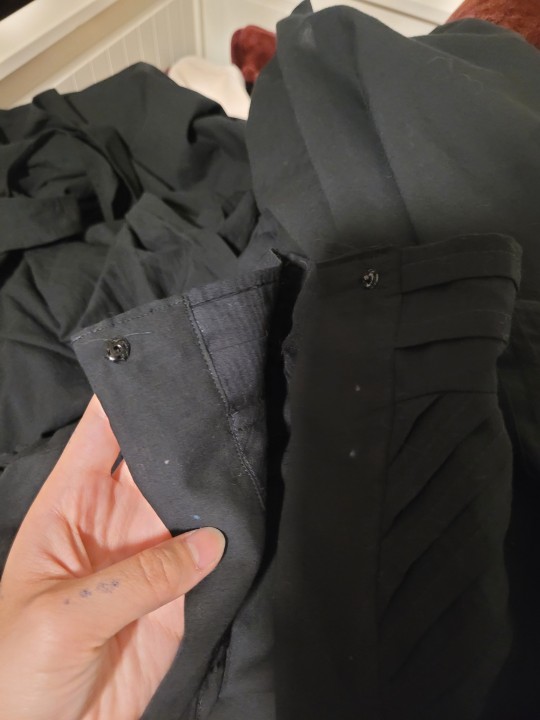
I tried on the blouse and skirt together:
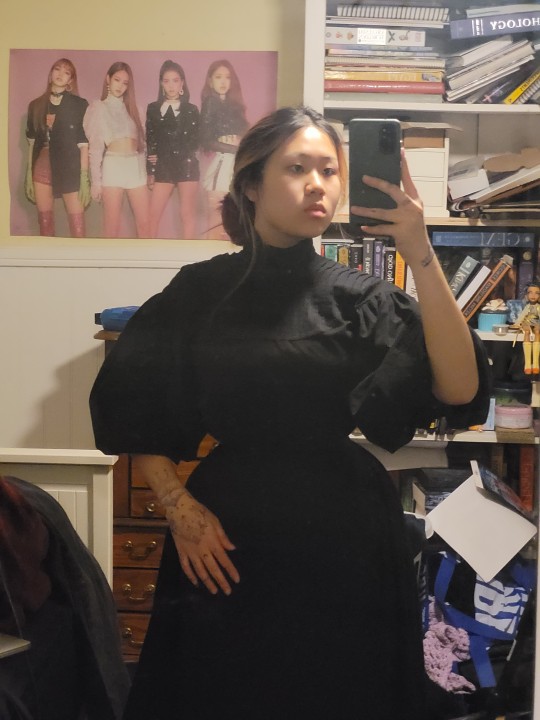
I may need to loosen the waistband of the skirt, the corset is a bit bulkier than i thought itd be. Also the blouse is just stuffed into the skirt and currently only has one closure on at the collar so it looks a little bit disproportionate. The belt/sash will help smooth everything out so i dont look like im drowning in voile.
I might go without the bustle pad during the final shoot because i think it gives too much volume in the waist/hip area for edwardian tastes. Its from an 1890s pattern, so the silhouette is a bit out of date. I should probably try the skirt on without the pad before extending the waistband though.
Im pretty happy with how the sleeves turned out! I have some vintage nottingham lace i bought on etsy from penelope textiles that i was going to add to another project. I think ill sew some different laces together and add it to the cuffs to elongate them a bit. Since this dress is supposed to be from roughly 1905, i want the sleeves to look as they wouldve in that time. The photos ive seen mostly feature large ruffles at the ends of elbow-length sleeves but i dont think ill be likely to wear ruffles very often. Ive also seen tighter cuffs that extend from the elbow to mid-forearm or from the elbow to wrist. I think the elbow-length sleeves are a feature of afternoon dresses but i could be wrong. Maybe that was just day dresses? Not sure.
Im also not sure if i want to get gloves/a hat/parasol for this project. On one hand, it would look really cool for the video. On the other hand, it sounds quite expensive and i doubt ill wear it again. I dont want to buy things i wont use and create waste, theres enough of that in fashion. I have a pink 1900s parasol that i might cover with black fabric, but idk.
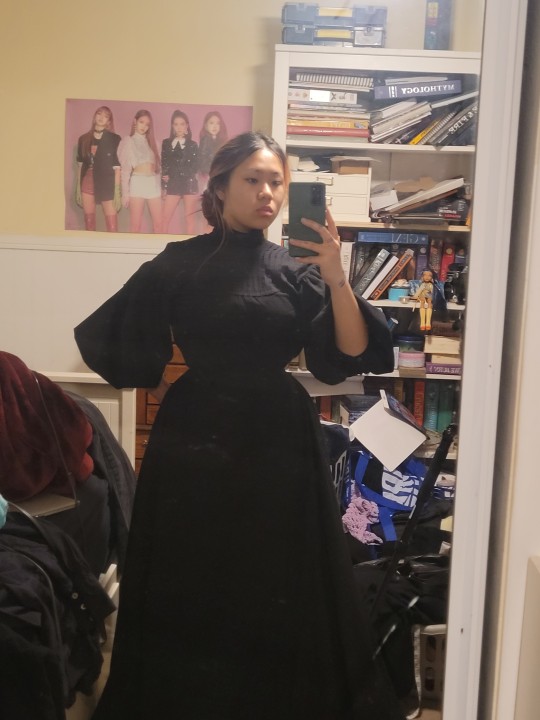
There isnt much left to do! Im gonna make a list here so i have it written somewhere:
-sew snaps onto blouse
-finish blouse hem
-attatch lace cuffs
-press pleats on sash/belt
-order synthetic whalebones
-add bones, hook/bars to belt
This is just the sewing tasks though, i need to edit the video clips and record audio. I have no idea how to do any of this. I just downloaded davinci video editor so hopefully i can figure it out. The only experience i have with video making/editing was in 3rd grade on ipads on the imovie app. Ive just been binge watching bernadette banner videos bcs i love her video style.
Any tips/feedback are much appreciated! ♡
Date: 4/22/24
#edwardian fashion#1900s#early 1900s#edwardian era#edwardian#victorian mourning#victorian dress#victorian era#victorian fashion#fashion history#historical costuming#historical dress#historical fashion
102 notes
·
View notes
Text
I wrote this elsewhere for someone who was struggling to find information, and then realised it was probably relevant to many other people too, so I’ve expanded it a bit. Therefore I present;
Which boning do I want? A guide
Flat steel; flat steel flexes front and back, not side to side. Heaviest option. Pricy. Difficult to cut and finish (will tear holes in your project if you leave raw edges). Expect bolt cutters and a metal file, or faffing around with “tipping liquid” which may or may not be illegal to post in your country (Nail polish is only a temporary alternative in my experience). Will last a million years. Extremely robust shaping. If you want to hold up an entire garment on 3 bones; flat steel. DO NOT WASH (I’m not your real dad but also it does corrode eventually if you keep getting/leaving it wet)
Lot of people swear that even if you use different bones everywhere else, you want flat steel next to your eyelets. Personally; eh. This appears to be convention rather than based in solid evidence (bunch of extant Victorian corsets don’t have steel by the eyelets, some do, a lot we don’t actually know). Go with your heart and your wallet, especially for special occasion pieces
Spiral steel: flexes side to side as well as front to back. Lighter than flats (in theory). Pretty robust and long lived. Easier to cut than flat (still metal, still bolt cutters), but made of wire, basically, so you have to buy metal end caps and fit every single one with pliers. Cheaper than flat steel. Generally agreed to be more comfortable than flat steel but again. Still metal. DO NOT WASH NO REALLY I MEAN IT THIS TIME this stuff loves corrosion
A lot of modern corsets are a mix of flat and spiral and they will tell you that’s for flexibility but it’s usually for budget
Zip ties: cheap and they work, pretty much, but mainly cheap, extremely variable in thickness/size/flexibility, did I mention cheap? Don’t buy random ones online; you want to handle them and be sure they’re the size/rigidity you’re after (or even just feel good about. Some zip ties are incredibly flimsy. Heavy duty ones tend to also be thicc). Generally washable, but with highly variable results
Rigilene/other generic plastic boning: wafers of flimsy plastic. Surprisingly expensive and won’t hold up to a stiff breeze. Disappointment city. Washing sometimes also kills it? When people whine about plastic boning, this is what they’re thinking of
“Synthetic whalebone”: really fancy plastic. Consistent width/thickness/rigidity. Several options of width usually. Very light. Good balance of support and flexibility. Can cut with heavy duty scissors and finish with a nail file. Mouldable with heat. You gotta buy a lot at once, but not ultimately expensive in comparable amounts (big rolls, per metre, more cost effective than heavy duty zip ties; but are you gonna use 50 metres of boning?). Washable in a way steel just isn’t; must warn you that the whole “mouldable with heat” thing also means “very occasionally the tumble dryer kills one of my kirtles and I have to dig out a bone and replace it”
Synthetic whalebone means adjusting the way you think about boning a bit; one bone is not as strong as a flat steel. That doesn’t mean (as I’ve seen some people say) you can’t use synthetic whalebone if you’re fat; it means you’re going to want two, three or four bones side by side to do the same job. This is exactly what people did with real whalebone (good lord if you’re making 18th century stays or equivalent don’t use steel, it’ll be so heavy and uncomfortable). You can even put two bones in the same channel stacked on top of each other if you make it big enough. You tend to use more of it than you would steel, but it still usually works out cheaper - the “extra boning” channels thing only really comes into play for aesthetics (it is COMPLETELY FINE to pick the more expensive and difficult option for aesthetics and anyone who tells you otherwise is a coward)
#sewing#sewblr#historical costume#every time I write the word boning I know someone is going to make a joke and I just want you to know I made one first
34 notes
·
View notes
Text
I sewed a corset and laced it up and I felt like a god. Then I remembered that I made it for a historical costume so I took measurements for the outer clothes. Fellas. Literally nothing about my body shape had changed. I am already a post-Edwardian beanpole. So I'm skipping the fitting and picking up my corset cover because extant sources say that in cases such as these, "the slender girl" can get away with not wearing a corset. The corset will still be there once I regain my pride.
7 notes
·
View notes
Text
Exactly what uniforms were worn by state militia in the War of 1812 is a debatable question. Surely, many men wore hunting frocks and other irregular types of clothing; the United States struggled to field a professional fighting force.
But there is a certain trend I have noticed in how militia are depicted. You have, say, Kentucky militia—the Hollywood version!

(By artist Andrew Knez Jr., c. 2019, this is supposed to be at the Battle of New Orleans in 1815).
And then you have—with an actual extant uniform—a Kentucky War of 1812 soldier's coatee, reality version!

This belonged to a well-known public figure, Charles Stewart Todd, and you can find it in the Kentucky Historical Society's collection! It is not a manipulated image: he really did that with padding and (I assume) a Regency-style men's corset.
Another example of a real, extant Kentucky militia coatee belonging to Jarvis Jackson shows distinct Napoleonic era military style—and it's not a fringed hunting frock. He probably wore it with Hessian boots, not mocassins.

Anyway. I am slightly in a tizzy about this. Primary sources are few and far between, and I feel like I'm battling some kind of 1950s TV show mythology with coonskin caps.
#war of 1812#kentucky militia#military history#uniforms#dressed to kill#napoleonic#1810s#20th century ideas about rugged masculinity vs. what these frontier fighters actually wore#they liked tophats with cockades and plumes#they wanted to look nice by the standards of their own time!#dress history
19 notes
·
View notes
Note
Hi, while looking through extant garments in a museum collection for reference for a school project, I found several garments of different designs that were all labelled as "binder" without any other context or explanation. Obviously my first thought was the kind of binder I use, especially for the first one that looks elasticated, but I have to assume they're for something else like gynecomastia or compression..? Do you know happen to know anything about them?
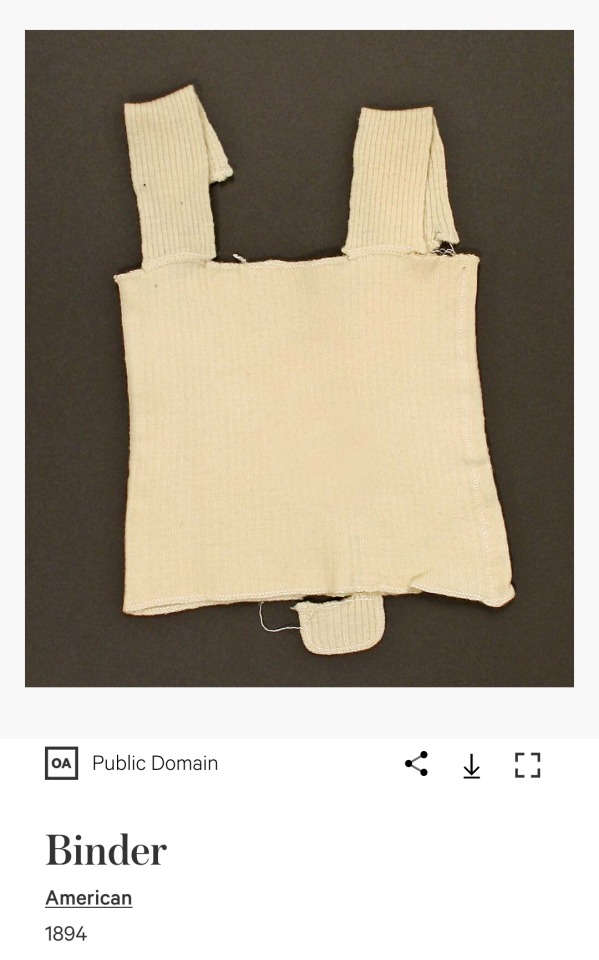
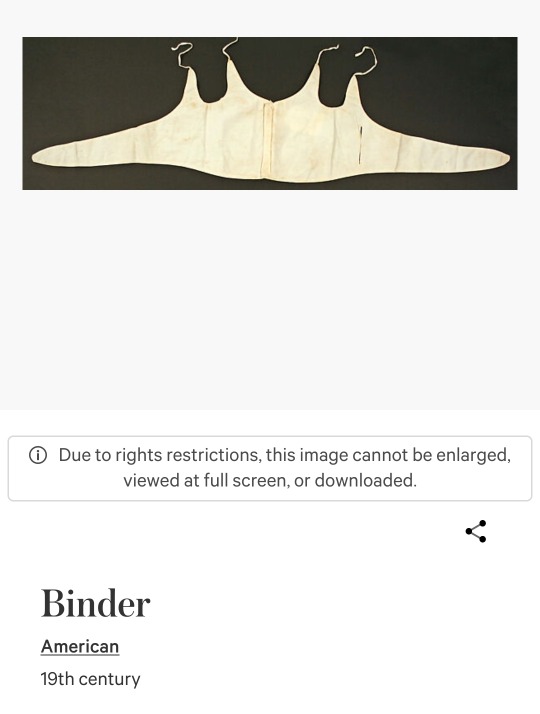
This is interesting!
They could actually be the types of binders you use. I immediately thought of 19th century male impersonators - female (?) actors who specialized in male roles in Vaudeville and other similar forms of theater, in which drag was integral part of, and would also have their own one man impersonation comedy and music shows and male stage personas. Basically they were drag kings. (Similarly female impersonators, basically drag queens, were also quite popular.) They were known to bind their chest, and other actors, who didn't necessarily do the impersonation shows, but played male roles on stage, would also often bind their chest for their performance. Here's for example two successful male impersonators, British Vesta Tilley (first picture) and American Ella Westner (second picture).
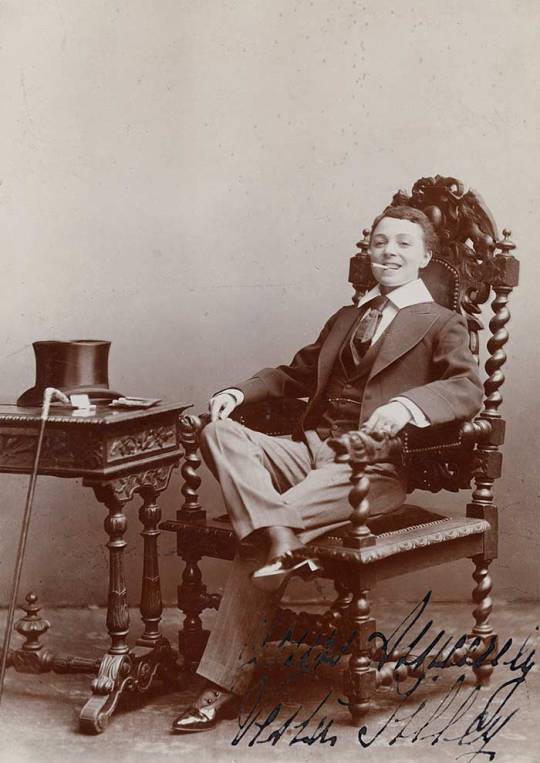
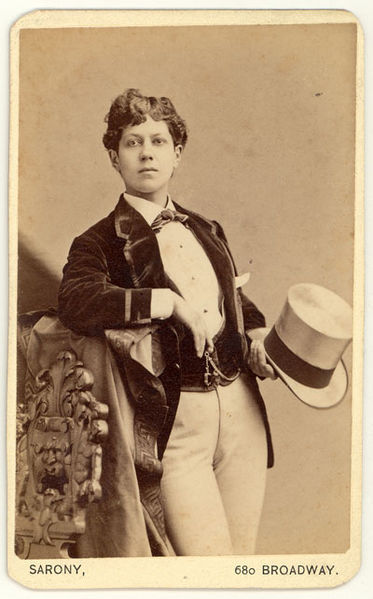

Queer women and trans masc people, who dressed in masculine clothing, (which was pretty common) also sometimes bound their chests, but unsurprisingly that was not exactly celebrated like drag performances were, so there weren't binders made for queer people specifically. I'm guessing they either made their own binders or used binders made for actors. Often those actors were the same people as those queer people, since drag performance was one of the few socially acceptable ways to fuck around with gender. Not all of them were queer, Vesta Tilley looks excellently queer in her drag, but outside stage she was respectable member of high society and very supportive of her husband who became conservative member of parliament (after she had retired). And I think we can easily imagine what kind of political opinions about queer people she was supporting when he was conservative in the context of 1923 Britain. But many of them were known to be queer, like Ella Westner, who eloped to Paris with a very interesting woman, Josie Mansfield (pictured in the last photo above), who was mistress to an infamous scammer and the man who murdered him. Westner was also buried in men's clothing by their own request.
I couldn't find pictures though what did the binders used for chest binding looked like, so I decided to look into what kind of other binders were used in the era. I think the first binder or perhaps both of them could be baby/infant binders (first two pictures below). Apparently people in Victorian era (and in 18th century) believed that chilled abdomen could cause cholera and I guess other bowel issues, so they treated cholera and tried to prevent it by wearing binders and belts (last picture), which could be also made from flannel or wool knit for extra warmth. And babies are quite vulnerable to bowel issues and cholera, so they made binders for babies too. I've seen many different types for these (for both baby and adult use) with some of them like cloth wraps, and some of them kinda corset looking though not corset shaped. If the binders you found were indeed for abdomen warming purposes, I'm sure they are for babies, since those for adults would be so low there definitely wouldn't be shoulder straps like that. The proportions on the first binder especially seem to me fitting for a baby, like the straps feel a bit too wide for adult scale. The second one is harder to guess, it could be a baby binder, but it seems to have boning in the middle, which would make maybe more sense in a chest binder?
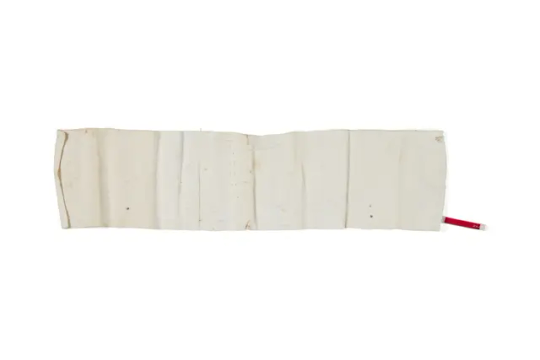


But yeah Victorian medicine continues to be... interesting.
#extant garment#historical fashion#fashion history#history#victorian fashion#queer history#undergarments#historical clothing#dress history#historical binder#photography#answers
100 notes
·
View notes
Text
Documenting one of my projects here!
Im taking an anthropology class called Magic, Witchcraft, and Religion, and our final proj is to present any topic relating to the class in any medium. My topic is Victorian/Edwardian mourning rituals and customs. I chose to recreate an Edwardian (c. 1905-ish) half mourning dress!!

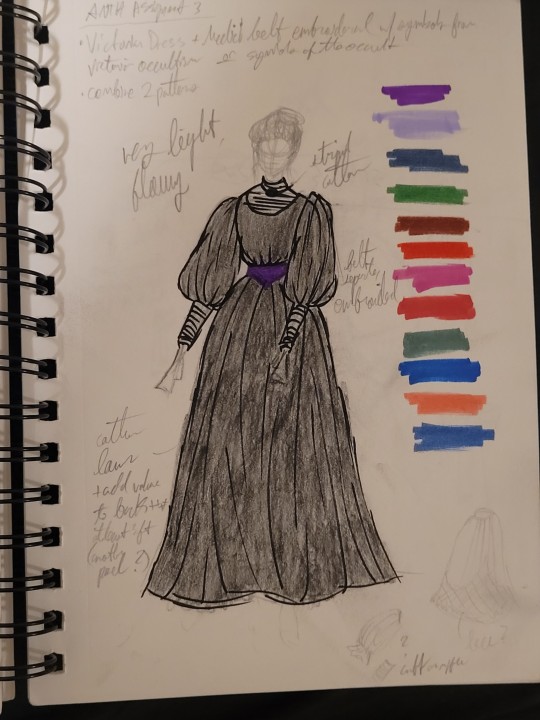
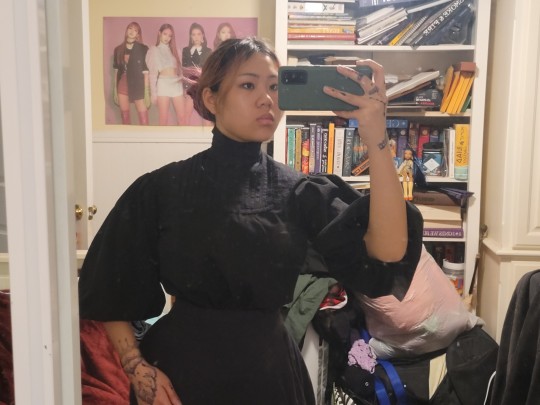

So far, ive went through several rounds of designing and 0 mockups bc i dont have time for that. Im recreating everything using only methods that would have been available at the time. I currently own 2 antique sewing machines from 1911: one hand crank and one treadle. A lot of this project will likely be done by hand because i just enjoy it :)
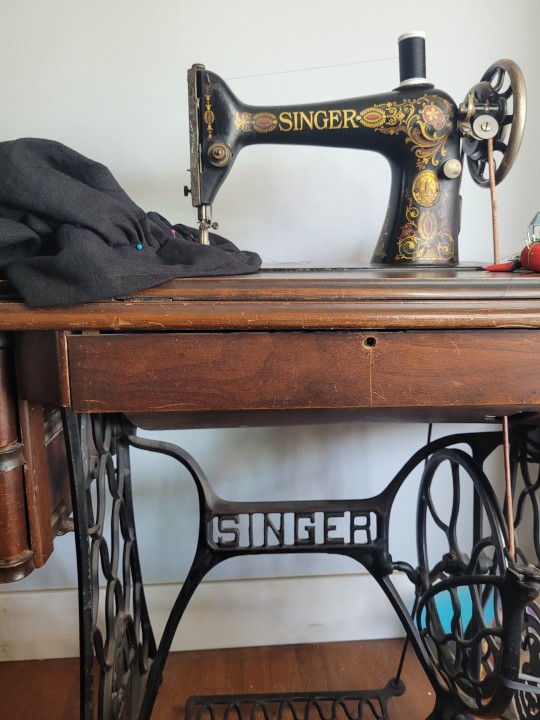
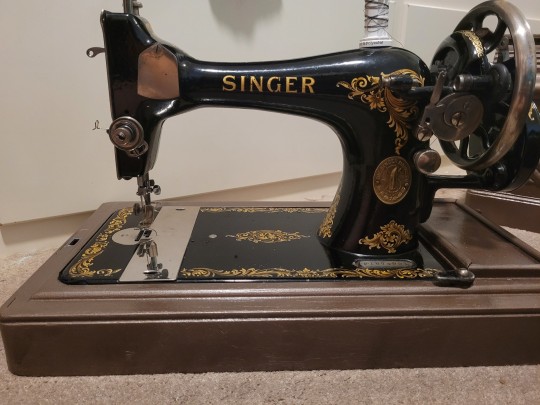
I'm using a cotton lawn, which, according to Victorian mourning guides, would not have likely been used because the dyed might bleed onto the skin, but I live in a very hot area and will *absolutely not* be wearing wool or silk in 95F weather. The sash is (regrettably) poly taffeta because i dont have the money for silk. Im using snaps and a few vintage buttons for the closures.
Above are pics of some sketches, a blouse fitting, and the belt/sash ive draped. Ive seen similar sashes on lingerie/summer dresses and thought it might be fitting. Taffetta probably wouldve been used towards the end of half mourning according to etiquette books, but ive found extant examples that suggest otherwise. I also found that etiquette rules were a bit more relaxed in Edwardian times compared to Victorian.
I have the skirt and blouse placketts cut out and i need to attatch them. I might add some lace to the cuffs but idk yet. I kinda like the simple short cuffs but a lot of 1905-6 dresses ive seen have large ruffles at the sleeve. I dont really want to make ruffles but they do look cool. I also have a chemise, bustle pad, corset, and petticoat done but i felt weird posting a picture in (Edwardian) underwear, even if it covers much more than our modern underwear.
I will be updating this page and plan to present this project in video format on youtube, ill post a link here once I finish!
Date: 4/19/2024
#edwardian#1900s#1905#fashion history#victorian mourning#victorian era#edwardian era#victorian dress#historical dress#historical costuming#mourning dress
67 notes
·
View notes
Text
It's crazy that Stefania came of age and got married before the bra was patented or popularized as an undergarment. Like I can date that photo from before WWI not just by the cut/style of the dress and her approximate age but by the fact that it's the only extant photo of Stefania clearly wearing a corset
9 notes
·
View notes
Text
fem!William cosplay
In honor of sherliam week 2023, I'm gonna start posting about my plans for a hopefully historically-accurate cosplay of William! :D
i'm planning on designing 4 outfits: professor, noblewoman day wear, noblewoman evening party wear, and traveling wear. I'm probably going to be actually making one of the first two or both. I could also throw in a teagown, loc outfit (though i honestly think it would just be the same as canon anyways?), sleepwear, specific design for undergarments, etc, but we'll see if i'm still interested in that later
when I first came up with the idea sometime in july or august, because i am such a historical costume girly, i was like, so i would do a male one except i know that i would never wear it outside of the cosplay, which would be a waste of my money and limited energy. So, i decided to just do a female adaptation of his canon character design and made a ~1878-1879 corset, with plans to make combinations (for that sweet sweet in-character practicality), corset cover, etc. Then, as i was working on the design, i ended up coming up with a whole au/justification for an actual female ver. of william that was publicly known in-universe as a woman who identified as such with the og william also being publicly known as a girl, because if he was still a boy, then f!william would have had to cross-dress. Also, if anything i'm saying is irl historically wrong, i'm literally begging for you to tell me and forward resources about what im wrong about.
So, essentially, in the 1860-70's, specifically including ~1876 - 1879, there doesnt seem to be as much popularity towards women being highly educated through universities or being teachers at universities as it is in the later victorian era, though there already has been precedent set for a couple decades of women graduating from college. So, if a female william (f!william for short) was a well-off and decently mid-high ranking noble lady from a family with an earl/count title, it could be presumed that trying to be a "perfect noble" (wo)man would not involve being more noticeably progressive in such an eye-catching manner. However, considering that in canon william doesnt try to downplay his intelligence at all publicly, given that he is known as a mathematical genius who graduated and became a professor at a very unusually young age, even f!william would probably be stubborn enough to fully go for it and achieve the same results, with a lot more opposition from strangers. Admittedly, a woman would not have been allowed to attend Eton, because it's all-boys, and being titled a professor means that you've been hired as a professor at a university, and i imagine it'd be hard to get a bunch of likely sexist-ass old men to hire a young woman as a professor, but let's say she did manage to do it, especially with the backing of a respectable noble family name. So that means she's a ~19 y/o publicly-known-as-21 y/o to ~23 y/o publicly-known-as-25 y/o who is going to be starting to teaching mostly young men, who are almost entirely well-off to noble status, in ~1874-1878. That's the tail-end of the first bustle era and in 1876 the natural form era starts until early 1880's. So i looked at a lot of fashion plates and extant garments from this general time period to get a sense of both eras to design a dress that was first made during the first bustle era to be fashionable to that time that was then retailored to fit the natural form era's fashionable silhouette but also not being too fashion-forward since i dont think she would try to keep up with that more than necessary as it isnt her priority, because it's possible, even likely, for f!william to be more practical/frugal by choosing to have an "older" outfit retailored to fit a new era's style than have an entirely new outfit made. Side-note, there is practically no way to pass off the button-up shirt collar design as a historically-accurate fashionable lady's collar, so dont @ me about that. Currently, this is the design i've settled on for the professor design, which would be worn while teaching at Durham uni and possibly also as daywear on the days she has to go to work there.
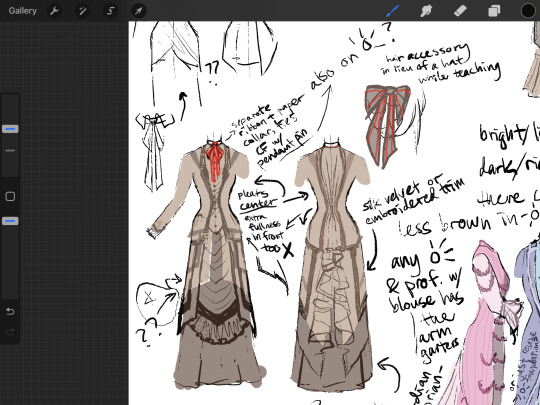
the dominating collar scheme for all the daywear options is brown, and while i could have used more red in accordance with the canon red tie and eyes, i again know that my wardrobe doesnt do red, so that wasnt really a choice in terms of the main body of the dresses if i want to be able to wear any of it normally. This one also needs to have the color layer updated. For the professor outfit, I was keeping in mind a relatively simple/modest design- for a noble lady- but especially in the back where male students would probably see a lot of (since she would be also writing on the blackboard), because anything too complicated or eye-catching could be "distracting". i didnt want to make it too modest because the students and coworkers are also of similar social class to f!william, so there is some expectation of dressing well for her station but also not being too distracting for the young male students :/ i'm still considering toning the design down more, but im not sure how....
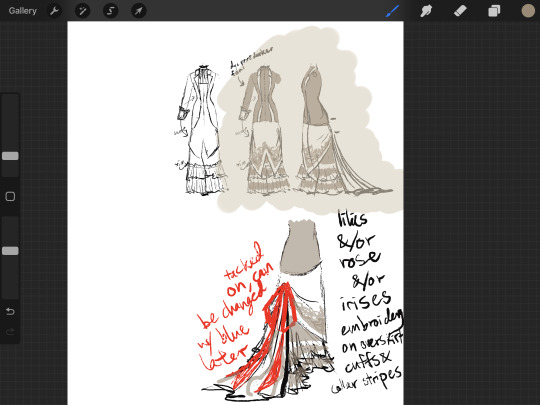
this is what i have for the normal noble lady daywear, hopefully appropriate year-round because i dont feel like designing a new outfit for like all 4 seasons. since it was by far more fashionable for women to wear brighter/lighter colors (usually more adorned by trims in matching/accenting solids rather than patterns for any time of year) during this time if it wasn't winter, in which case it would be dark but still rich colors, i made the browns a lot lighter to compensate for the fact that i'm trying to a. keep close to canon design and b. again, i want to be willing to actually wear it normally, so no reds or pinks as a main part. the big red ribbon will just be tacked on lightly so i can take it off when i'm not cosplaying. I also try to incorporate more of the pressed pleats trims as a nod to william's whole thing about perfectionism, precision, and preparation, as well as him being a math nerd, but like that also ties into the... 3 P's?? so *shrugs*. I also just love the trains of the natural form era so of course I had to add that here, where i can go wildly unpractical, in comparison to the professor one, which does have to account for a good bit of walking by foot across campus and possibly through town. this is also subject to change, but i like to think it's mostly set in stone here.
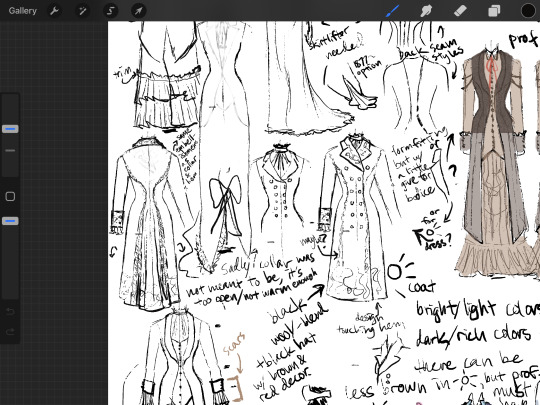
i also designed a black coat as a noblewoman adaptation of the one william wears in canon, which you can see him wearing when he and albert are at adam whitely's park opening speech. I'm not entirely sure about the exact nature and design of the embellishments, but its probably going to be some amalgamation of beadwork and embroidery. i'm actually also going to be making this, straight up because i want a black coat anyways lol. too bad it's not in time for this years winter. i didnt actually draw out the design for the hat but i was planning on a black base hat with brown and red decorations to tie it to any of the daywear clothes, including the coat, and maybe with a sheer white veil in the back? that was in fashion like during at least the mid 1870's. I'm also adapting the cane to an umbrella/parasol. while it'd make more sense to be a delicate litle parasol, i already have a normal-sized black umbrella with a silver metal handle, so that's like a perfect prop that mimics the dark wood cane with a metal handle that william uses in canon, though my umbrella doesn't have a sword hidden in it haha.
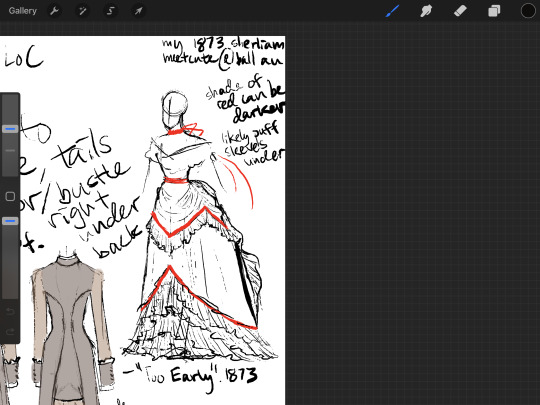
also, as a fun aside, in 1873, there was a brief trend for women to wear a ribbon choker that tied in the back with long tails as an evening wear accessory. so this is a sketch of a painting's outfit, dont remember the name though, that was painted in that year. Correction, I just saw that I wrote it down and its name is “Too Early”. I couldn't help but think up a fun little au of an au where f!william, who would be 18 y/o publicly-known-as-20 y/o, was at a ball and sherlock, male or female? (though i think a female sherlock would be kind of weird considering his canon bias that women are emotional, not as logically intelligent, and delicate :/), was also dragged there by mycroft or something when he decided?? to briefly visit england instead of presumably??? staying at whatever college he was studying at in paris. So, i was originally thinking that it would be such a cool image of sherlock lightly grabbing the tail ends of a red ribbon choker that f!william was wearing with a similar vibe as that sherliam manga vol. 14 cover art, as william turns to look over her shoulder at sherlock. But then, i obviously had to justify it to myself, so i came up with the whole above scenario and i guess they ended up meeting and becoming interested in each other a la canon but earlier and at some point in the night, william was teasingly staying (physically) one step ahead of sherlock and the image is when sherlock finally managed to catch william.
so i guess i'll post updates as i go? i'm definitely estimating this to be a year(s)-long project, considering all the research, patterning, and sewing i'll be doing. i'm also planning on doing a photoshoot with the cosplay when i'm done, so i'll be posting those whenever i have them ready.
edit: I just briefly skimmed a little of the history of female scholars, and apparently the first one to become a professor during the Victorian era is credited to Edith Morley, in 1908 at the age of 33, though there were some other women who also attended a male-dominated college around the same time as her in the 1890’s. Thus, for f!william to have been able to get that professorship or even attend and graduate from a college with a proper degree ~1869-1873, that would have been seen as even more extremely radical, which would have made her stick out in high society in a way that would make it harder to convince targets like lord Enders that she was similarly elitist and a “proper” noblewoman. She also would have had to convince both count Rockwell, her guardian, and the college itself to allow her to attend at ~14 y/o publicly-known-as-16 y/o and maybe even graduate with a proper degree, probably through a lot of machinations on her part, not to even mention being a professor. The only advantage to be found is that she’s seen as a noble, so there is some influence to exert to match male-dominated college chairs.
9 notes
·
View notes
Text
gonna be a fashion hater here for a moment… i’ve been avoiding that new corseted collection even as all the historical people i follow on ig praise it because i avoid tightlacing and its silhouettes for my own body image sanity and i’m soooo sick of the corseted wasp waist being praised when it’s only achievable for certain bodies (read: long rib-hip gap) (i’m bitter i can’t do this). anyway i just looked at it here and it’s fucking galliano?? the guy too antisemitic for FRANCE? lol.
anyway as a historical corsetry enjoyer i want to see it PRACTICAL. on real/working bodies. the people who didn’t go to fancy parties or tightlace, but used it for bust and back support. obviously extant garments are far more likely to come from upper class people for many reasons. but i’m soooo sick of the bias in historical fashion towards luxe and impracticality at all times. obviously i’m not expecting this from high fashion but just frustrated in general.
and yes i am guilty of adoring galliano’s 90s poiret inspired collection for dior. the man is talented. but there’s a difference between appreciating old work and actively hiring him now
6 notes
·
View notes
Text

When I was regathering my long-neglected research for my Helga Sinclair ribbon corset, I rediscovered this gorgeous extant example in the V&A from 1895. Unlike most extant examples I've come across, this one doesn't feature overlapping ribbons. This suggests that it was made for a particularly slim woman who needed very little support and for particular summertime breathability (supported by the garment waist measuring 19", suggesting a laced waist of 22-24".)
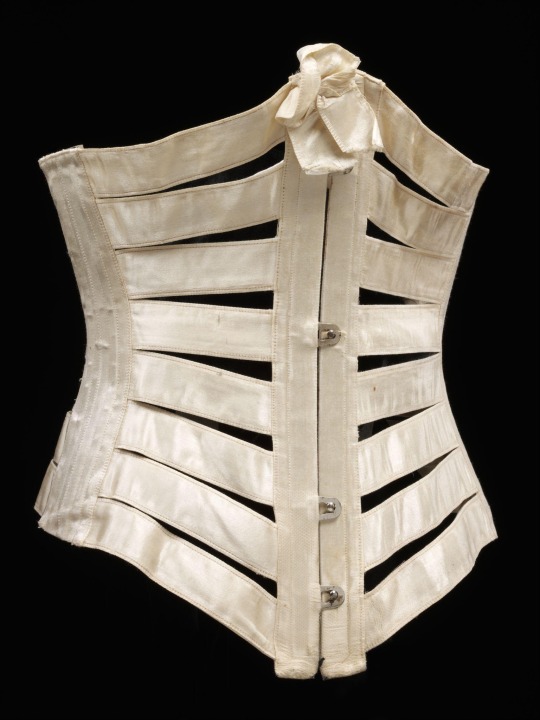

To me, long-since trapped in The Locked Tomb, the ribcage-like appearance was inescapable. Wouldn't you know it, I have a Crown Prince Kiriona Gaia costume that I started a year ago that was needing a little something something to pull the design together and to help motivate me.
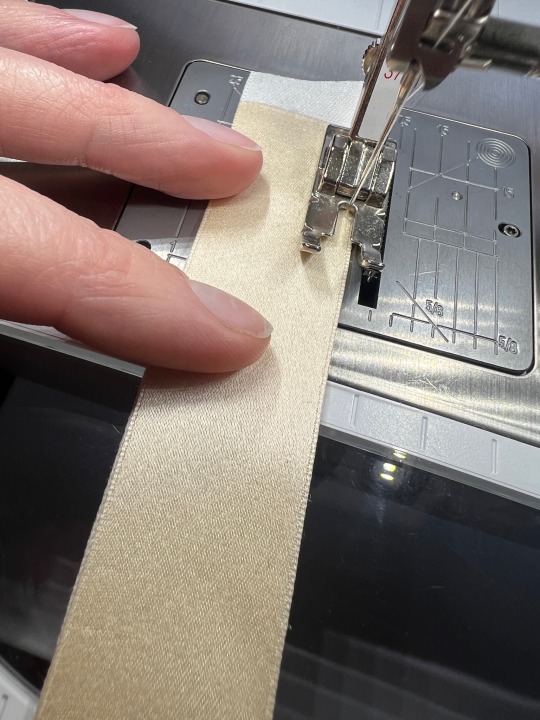


The pattern was adapted from my Helga ribbon corset, allowing for 24mm wide ribbon to meet at the sides and spread evenly in a ribcage like fashion at the front panel.
This time I used a beautiful shell-coloured silk ribbon. The ribbon is so beautifully soft, that it was a nightmare to work with. I do not recommend it for something that needs quite so much working as it marked with so much as a hard look! I am fairly certain that the V&A example the ribbon is self-mounted, so I again mounted my main ribbon, this time on a white cottong taffeta ribbon. If i slipped with my mounting or the ribbon twisted or buckled, i thought the white would be a suitably stark and skeletal contrast to the main silk ribbon.
As I am perhaps a little more fleshy than the lady who owned the original 1895 example, I cheated and also added a base layer of nude tulle to help smooth out the laced-up silhouette.
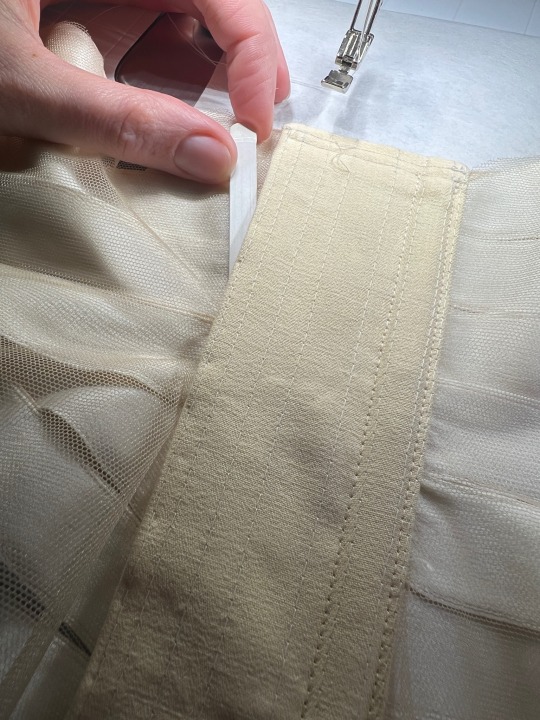

The overall construction process was the same as Helga: quilted the ribbon panels across the boned panels before covering and sandwiching them, and inserting the bones from the side to allow for for hem stitching.
To finish, another ivory powder-coated busk and stitched over eyelets for security.

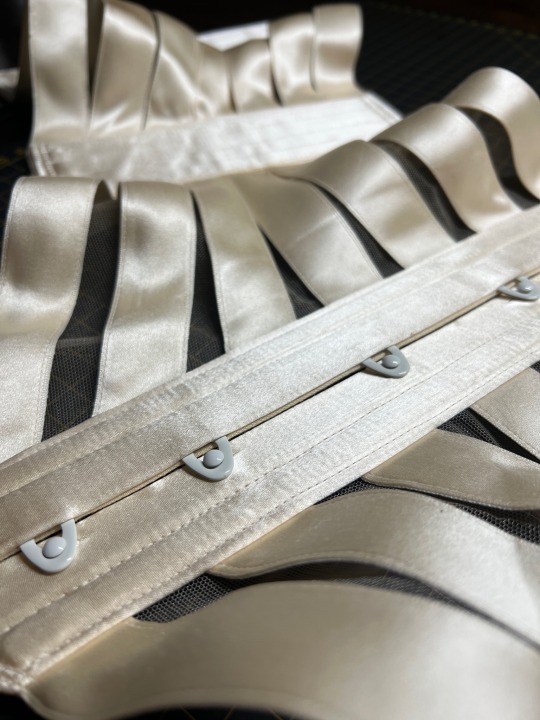
References:
Underwear Fashion in Detail, 2010, Eleri Lynn
Corsets - Historical Patterns & Techniques, 2008, Jill Salen
Corsets & Crinolines, 2017, Norah Waugh
1895 Ribbon Corset, V&A - https://collections.vam.ac.uk/item/O138887/corset-unknown/
How To Make A Basic Ribbon Corset, Sidney Eileen - http://sidneyeileen.com/sewing-2/sewing/corset-making/basic-ribbon/
An Edwardian Ribbon Corset, History Wardrobe - https://historywardrobe.wordpress.com/2014/04/10/an-edwardian-ribbon-corset/
#project: ribbon corset#project: crown prince kiriona#media: the locked tomb#the locked tomb#Nona the ninth#Gideon nav#Edwardian#historical sewing#historical dress#costume#cosplay#project wip#making of#poetry in costume
190 notes
·
View notes
Note
Kind of random question, but one that’s been nagging at me for a while. Do you know how women historically dealt with thigh chafing? Whenever I wear a skirt I need to wear bike shorts or bandelettes or something to avoid serious pain, and I know historical undergarments didn’t cover the inner thigh area any more than modern ones, and that tights weren’t common until the 20th century. So what did women do before that?
Would you believe that Real Professional Dress Historians debate this a lot
especially the ones who've worn period clothing at some point
and we still aren't sure because thigh chafing is just...not talked about in extant literature much at all. if ever. even menstrual products and Corset-Based Breast Support are mentioned more often, which is saying something, because those are high on the Not Talked About lists. I haven't seen it yet, personally; it's probably out there somewhere? hopefully? but yeah it's rare
current best guess is pushing your shift between your legs (or just letting it naturally get into that position while you walk in the morning, I suppose). split-crotch combinations and drawers usually have so much fabric in that area, despite the open seam, that I feel like you could still get some chafe protection that way
a Very Good Question we're still working on figuring out!
384 notes
·
View notes
Text
I’m planning my Imogen Critical Role (level 9) cosplay and I’m currently in the process of deciding how much of a crazy person to be for making it.
Long, drawn-out thought process is going below the cut so I remember what the hell I was thinking later.
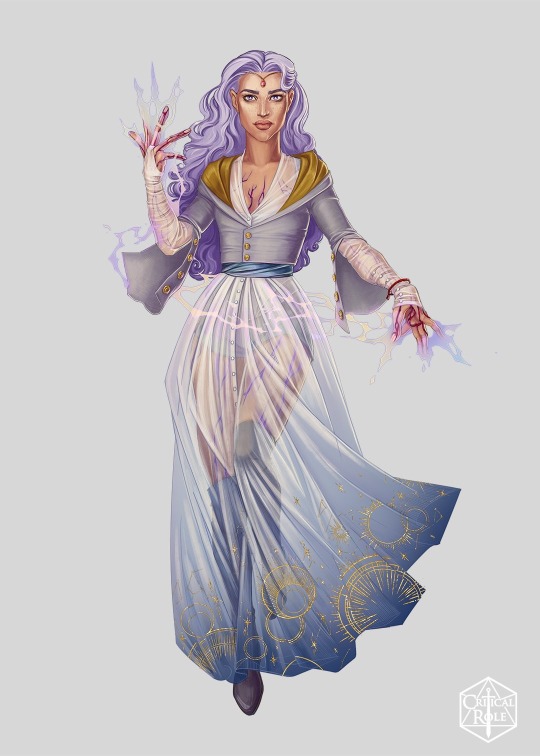
So this is The Design. The big question for me is, what’s going on with this part of her outfit:
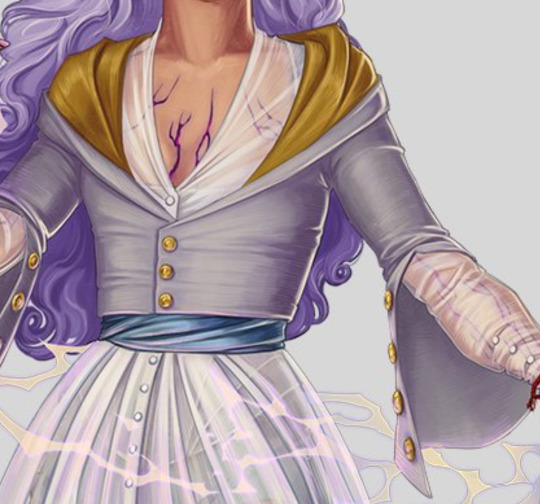
Starting from the bottom layer up, whatever the base layer is makes me insane because of the seam placement. It looks kind of like it’s supposed to be some kind of corset or stays, on account of the seams being kind of like hip gores. I’d lean toward stays because there’s no center front busk (and because the top of it looks flat, which is more consistent with stays overall). However:
this not going to be terribly visible, since it will be under an entire other coat
technically they’re definitely not hip gores because the seam placement is super weird
There are some benefits to the unnecessarily complicated route, namely that stays would actually achieve the overall silhouette that Imogen was drawn with this time. She has a very flat bust, which is even more obvious because she has an hourglass waist + hips, which is best achieved by certain periods of stays/corsets.
The other benefit is that her weird little bolero is most similar to extant garments from the 1790s-ish. Particularly, this Redingote dress:

It’s definitely not EXACTLY the same, but it has a similar shape and, most importantly, you can find a ton of helpful pattern drafting information from LACM online. The jacket has a similar weird shawl drape collar… thing to what Imogen has going on, which is the key element.
So using stays might also help with the fit & silhouette of the bolero. I definitely don’t know enough about 1790s fashion to determine whether or not it would be essential, though 🤷♀️
On the other hand, I could just be a normal person and make the entire base layer out of stretch knits and just kind of wing the jacket, which is a more sane and probably lower-effort approach (unless the jacket-winging goes poorly).
🤔 much to think about.
2 notes
·
View notes
Text
Update 3
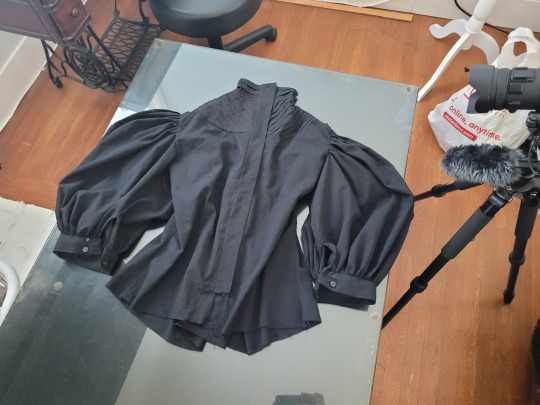
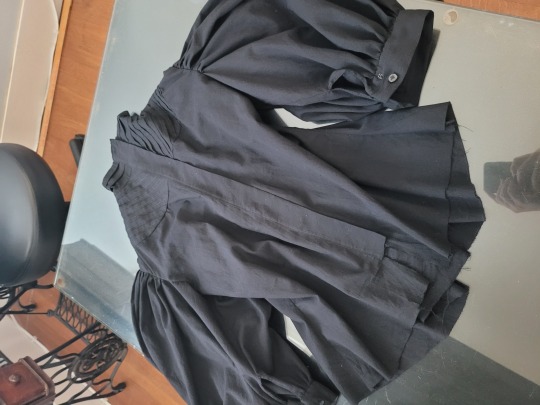
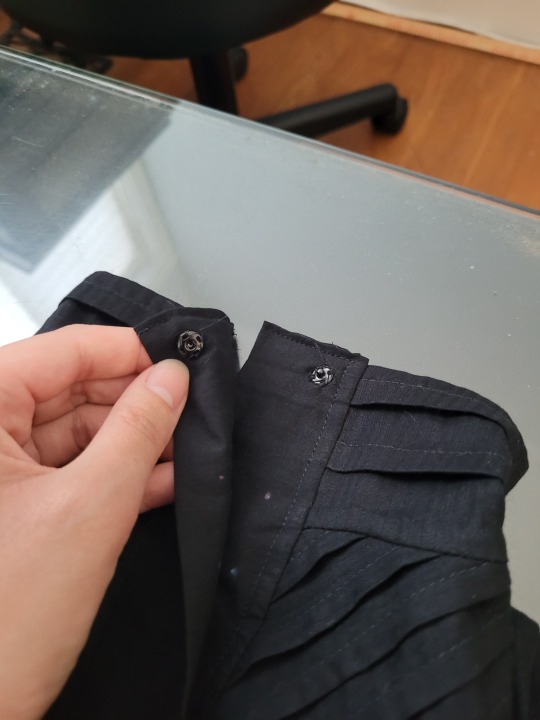

This is gonna be a pretty short update. I was mostly working on video editing and script writing today, so I didn't get a chance to sew. Video stuff is h a r d. It took me so long to decide on what music I'm going to use. The good news is that I have a clearer vision of what I want the final result to look like. Unfortunately, I can't yap as much as I'd like in the video because I have to present it to class. I'm trying to keep it in the 10-12min range, but I could probably fill a 20min+ video if I had a bit more time.
I took a few videos of some extant garments in my collection (not pictured because I forgot) including a late 1890s wool walking skirt and a pink silk day dress from the early Edwardian period. I'm not too sure on the pink dress' exact year but I know it's early-ish because of the gathers at the front of the bodice. It also has no sleeve puff like a lot of Edwardian gowns I've seen.
I'm still not too sure about my placket, it seems kind of wide. I really need to get a move on with the sewing because I have to film more footage wearing the finished garment and the semester is almost over.
Date: 4/26/24
Oh also! I tried on the skirt with a corset + no bustle pad and it fits just fine, I think I'll go without that bustle pad. Maybe I'll make an Edwardian one if I have time? IDK but the 1890s one gives the entirely wrong silhouette.
#1900s#fashion history#historical costuming#edwardian era#victorian dress#edwardian#early 1900s#victorian mourning#historical dress
10 notes
·
View notes